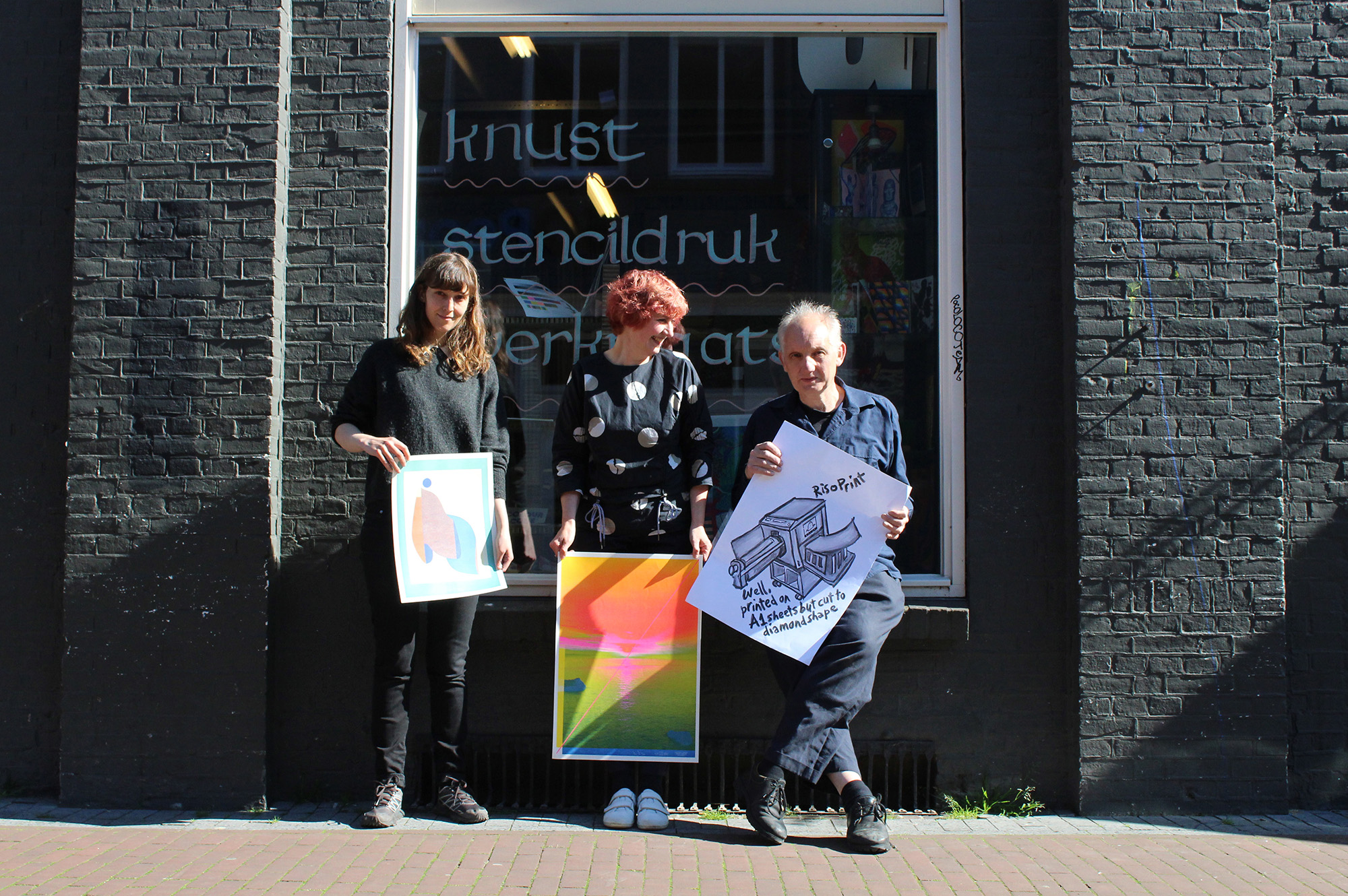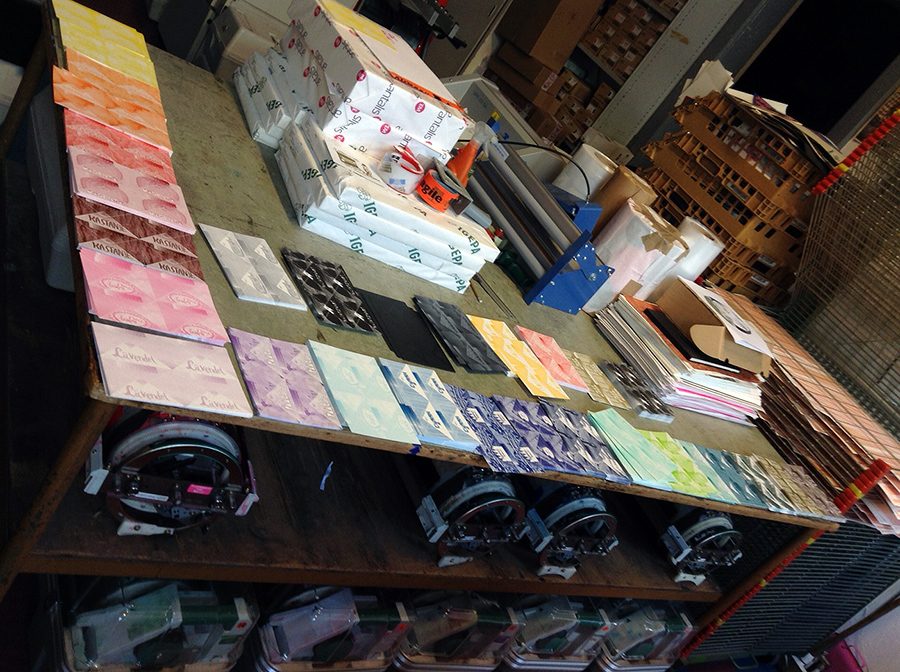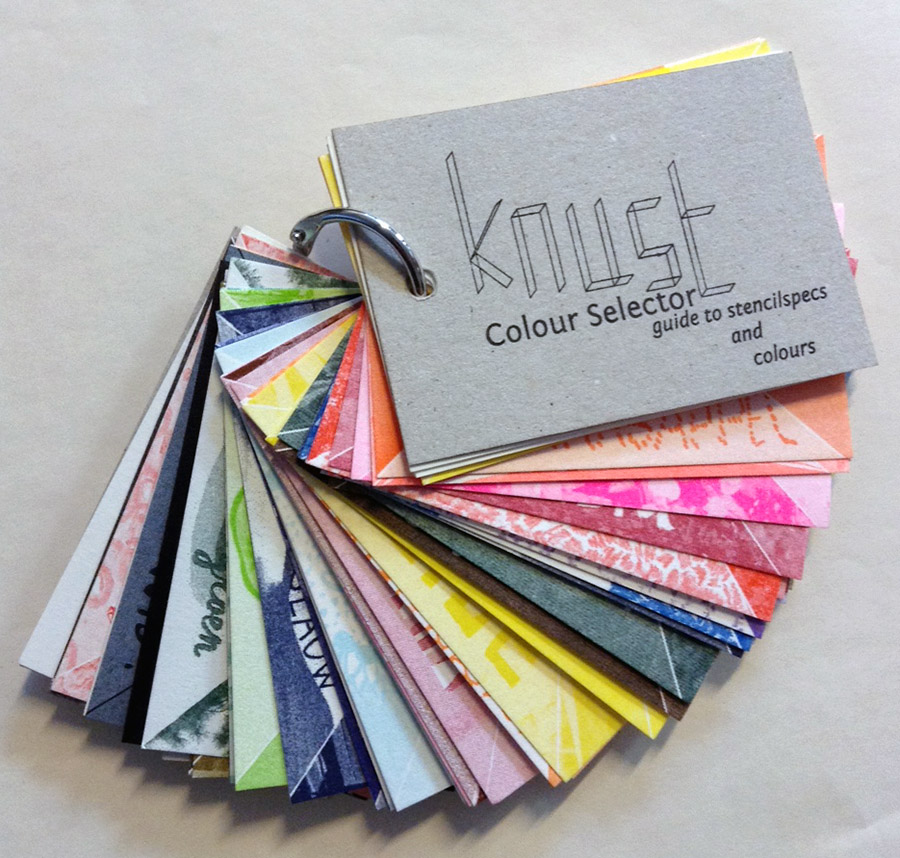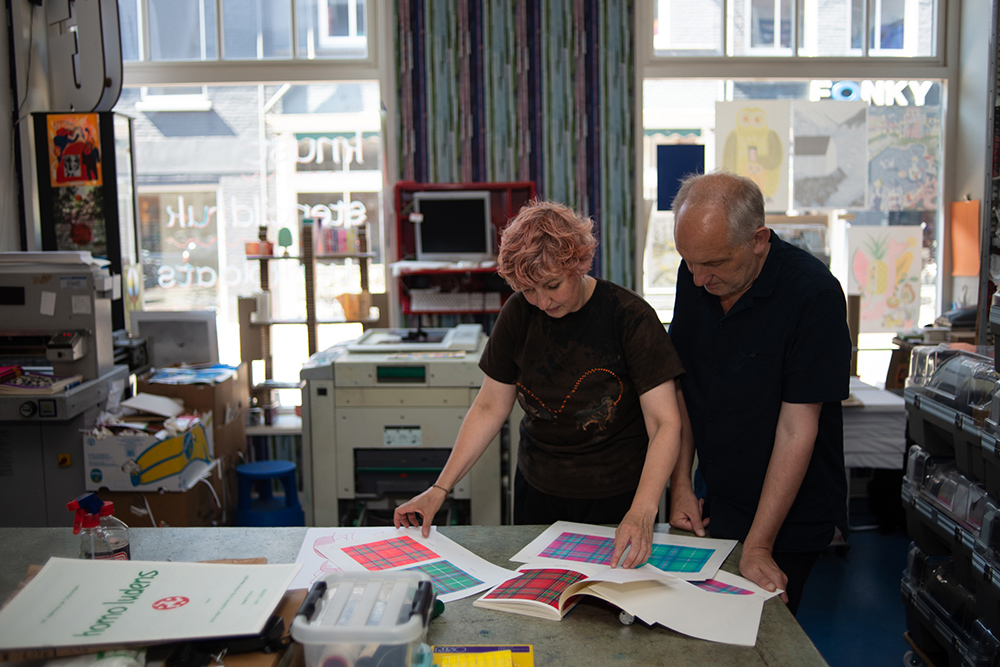Printing what matters
Knust is one of few presses that has for several decades been making quality zines, books and other printed matter using risograph (riso) printing: a stencil technique where interchangeable drums of color can be combined in any way the user wants. Based in the city of Nijmegen in the Netherlands, Knust is located inside the art organization Extrapool. They built up their studios in the formerly empty warehouse after being evicted from the squat where they started out printing zines on whatever paper they could get their hands on. Today the trio, consisting of Astrid Florentinus, Joyce Guley and Jan Dirk de Wilde, also arrange residencies and other events. To this date, Knust has made almost 250 books and they are still going strong.

How did you start Knust?
Jan Dirk de Wilde: We started as a collective in a squat where there were studios and a project space where I had a print shop. In the beginning, we were two or three people who were making zines. People from the squat also used the printshop to make their own zines or they took part in some zines we made. But basically, we were always working with only three people. When the squat was later evicted, we got into Extrapool, which is an art organization. That was in 1990, and there we sat up the print shop. Joyce joined in 1991.
Joyce Guley: And Astrid started in 2011.
It is impressive to have run something for such a long time.
Guley: I think it is partly because we had the Extrapool building. So we could just go on, which is an important thing. Often people do not have a building or they have to leave their building. We are quite settled here.
De Wilde: In the print shop there is always something new that keeps us going. In the beginning, we just made our zines and started collecting stencil machines for our own use. At that time, it felt more like play or as if it was not a permanent situation. We would print maybe one day of the week or when we had a project, which would be about 3 or 4 times per year. Sometime in the 90’s, we bought our first riso machine and became a little bit like the alternative printer in town; before that, we only had the old analog stencil machines.. Suddenly we were more like a company, and had so much work that we really had to think of ways to make time for our own publications at the end of the day.
Guley: At that time, we did not do any book residences. We did collaborations with other people and workshops, but less and less of our own work.
De Wilde: Before 1996 or 1998 we made probably 5 of our own publications every year, and then later on it became less. But what we had, until 2010, was a lot of people who wanted to make their books at our place because we were the only riso / stencil printing place around. There were so many proposals, which made it easy for us to say “We will print this book for you and then you can pay”. But if we thought the material was interesting, we would publish it together with them. I remember a couple of times people who studied in Amsterdam would want to make a book at our place before they went back to their own country. We never had to look anywhere else. For us it was very secure because there were so many projects and there was always something new – new machines or new techniques.
Guley: It is the only thing I have ever done on a daily basis. I do not have another job, there are no distractions. This is it! So, I put all my energy here.
De Wilde: We can live from this. We don’t really have a high income, but we can be independent and create our own projects. In the beginning it was really different, because it was easy for people to receive unemployment money and then do whatever they wanted to do. That meant that a lot of people in the squatting movement did not do much, except maybe go to some demonstrations. But we always worked reasonably hard and that is what has made us independent. Being the alternative printer in town was really funny, because most people who came here did not realize that the printing technique was special or different. They just thought we were cheap! When I went to a cafe or restaurant, I would always count how many posters were hanging there and how many of them we printed. I think at one point it was maybe 80%. Sometimes people who organized parties would come to us, wanting something glossy, so we had to buy a laminating machine so they could laminate their own flyers. And still we were cheap! Nowadays, sometimes people who came here 20 years ago come in, and they think we are really expensive because internet printing is so cheap. We charge the same prices we did 20 years ago, but then we were cheap and now we are expensive. But the artists, who really started coming after the year 2000, do not think we are expensive. For them, the paper is always very important and we always use good paper that fits the technique.

Would you take on any assignment, or are there things you say no to?
Guley: We probably say no if it is too corporate or not interesting.
Astrid Florentinus: Or an edition of one.
De Wilde: But it does not really happen often that something comes along that does not fit. 15 years ago, the guy with the coffee shop around the corner where they sell hash came around (there are a lot in town), but then we made the price so high that he never came back. We don’t really want to print that kind of thing. But that is the only time that I remember that there was something we did not want to print. It seems to always sort itself out. But nowadays, it is like Astrid was saying, a lot of artists who come and want to have one print or maybe 10. That is really expensive, but sometimes they still do it. Then we say you have to at least print 20 or 50 and they say “Okay, print 20”, but probably only use one or two.
Could you tell me something about the other activities you do?
Florentinus: Every year we try to do at least two big book residencies that are integrated into Extrapool’s program: Art Prison and Work Holiday. During a residency, an artist will come and stay here and we make a book together. The program that Extrapool ran used to be more sound art orientated, but recently there has been more interest in riso printing. Now a lot of the projects in the program are about making a book in the workspace.
Guley: We choose carefully from all the people that send in proposals. Often it is about 20 people, and we have to choose only one so it is really difficult. When we cannot choose, we ask people to make a print or do a different project in another way. We like people to come and make the book here instead of creating it where they live, even though that is not so usual. But Work Holiday it is just one week; Art Prison is two weeks, so then you can sit around a bit more. The artists stay at our guest room, and we live in the same building, and work in the same building, so it is kind of…
De Wilde: …claustrophobic.
Guley: No, it is very nice. We have a basement full of paper. We have old paper and weird paper, and it is important that people can choose their own paper, otherwise all books would look the same. And sometimes we use different machines or a new color. A new color is expensive, but it keeps us moving into new things.
Recent years I have seen more and more riso at art book fairs, and everybody seems to be talking about it. What do you think of the new interest in the medium?
Guley: I think riso is getting more interesting now. When we started doing it, we always had to explain what stencil printing was. Older people knew the mimeograph(1), but younger people had not heard of the technique. They thought it was like a weird silk screen machine. When a few people started getting riso machines they thought it was a very special technique, and made 1- or maybe 2-color prints and sold them for 10 or 20 euros each. That’s sort of not what the technique is about. I really did not see people experimenting in an artistic way with making prints in multiple colors, which is the nicest way of printing with these machines. But maybe seven years ago, people started developing their own techniques, and got more drums. The first work I saw was simple, but now it is really really good. Stencil printing is developing.
1) A mimeograph is a low-cost duplicating machine that works by forcing ink through a stencil onto paper. In the late 1960s, mimeographs began to be gradually displaced by photocopying.

Could you talk a little bit more about colors?
Florentinus: I just finished a book called Other Colors that is about the usage of colors when printing with riso and how it is specifically nice when you mix colors. How you get different tones, different hues… I went to Tokyo and got inspired by this Japanese book, A Dictionary of Color Combinations, by Sanzo Wada. My book is also about colors that are not so commonly seen together. In the end, I asked 10 different artists to each choose three colors that they also work with in their own work and that were unconventional to combine. At the moment, we have two old machines that are still working—which they might not do in the future, we don’t know. But right now, we have a big span of colors, making this a good moment to do a project like this.
Which unusual colors did you use?
Guley: I think you used copper and a bright gold. And an aqua.
Florentinus: There are prints with red and red golds, which gives a kind of brownish tone. And then there is aqua. When they mix you get a really weird sort of grayish hue.
Guley: You cannot define these colors. You cannot describe them with words. Olive-grey maybe, but that is not actually a color. I think this print is really beautiful where it becomes purplish and even greenish, even though there is no yellow in the print. That color is inside the purple, probably.
Florentinus: I will bring the book to the Bergen Art Book Fair, where you can have a look.
De Wilde: Printing with riso is about getting as many drum colors as possible. Riso as a company did not even realize until five years ago that selling drums was a big business. Before that they would have a lot of second hand drums, and we had special machines and would always buy them. At one point they did not have them anymore, because everybody wanted to buy them. The spot colors, all the different colors, that’s what makes this special. And it makes it more special when other printing techniques have gotten so standardized with CMYK (2). A lot of people think that riso is about happy accidents, and in a way it is. Sometimes things come out in ways we didn’t expect, but we set the whole process up in a way in order to control it. For the cover of Astrid’s book, she spent 3 days experimenting with 2 different colors, 2 different tones and 2 different ways of mixing. It really wasn’t necessary, but that’s the way you get the best result. It does take a lot of time, though. Sometimes we have artists who, when the first thing comes out, say: “Oh, this is good”. But then we say that we can make it a little more like this, or a little more like that. When they answer “no, it’s good”, it can be a little disappointing.
2) CMYK refers to the four ink plates used in most color printing: cyan, magenta, yellow, and key (black).
Florentinus: It’s a translation process, moving the work into the stencil printing machine. The colors are always more saturated with riso when you compare it to a different printing technique. And you can only print 2 colors at the same time. The colors can shift, and when they mix in a specific order, they can mix differently. If you would print blue and black first, and then yellow and red, it makes a difference.
Guley: With different kinds of paper it also works so differently. People think the difference between a white or a cream does not matter, but it matters a lot.
How did you learn all of this?
Guley: Through working with it…
De Wilde: …and experimenting.
Has something changed during the years you have been printing?
Guley: A difference may be the book fairs. In the Netherlands, although it is a very graphic country, there were maybe three book fairs, and most of them were about antique machines or etching, not about the artists or working with publishing. And nowadays it’s getting, phew… we go to about 8 to 10 or even more book fairs a year. You can see so much more, and you can exchange knowledge so much easier. And you can experience so many books!
